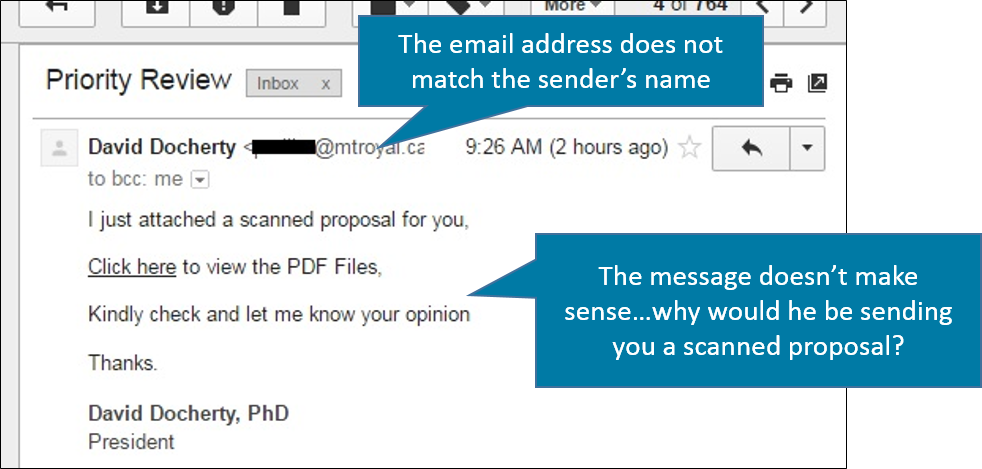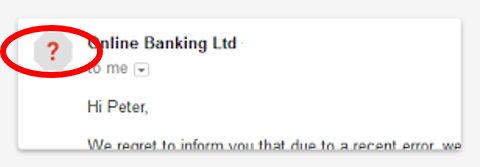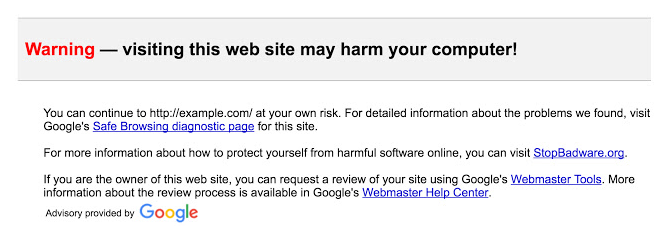Using Public WiFi Safely – 08/29/16
Keeping your Mobile Device Secure – 08/29/16
Our mobile devices have made our lives easier and more fun. However, because they are mobile it is easy to loose them or for someone to steal them. Also, because they are essentially mini computers, they are also susceptible to malware. Watch the video for some great tips on keeping your mobile device safe.
Using Social Media Safely – 08/29/16
What goes on the Internet, Stays on the Internet – 08/29/16
How to spot a suspicious email.
Currently Mount Royal University is being targeted with phishing emails from compromised @mtroyal.ca accounts. I know what you are thinking…how stupid can you be to fall for a phishing email? Well…here is an example of how sophisticated a phishing email can be. The following showed up in my inbox, twice…from two different senders. How did I know it was suspicious?

Notice what is missing from your standard phishing email? There is no sense of urgency. You know the sender. The grammar and spelling are correct. It even has a plausible topic and the new Gmail security features didn’t flag the email. This could be a legitimate email. How do you know for sure?
The answer is, you don’t. The only way to know if this is a legitimate email is to call the sender and ask them if they sent the email.
Before you click, Stop & Think!
Remember, we are only human. With the increasingly sophisticated techniques being used by cyber criminals you may end up clicking on something you shouldn’t. If that happens, don’t panic. Be a superhero and stop the cyber criminals in their tracks!! Disconnect your computer from the network and call the ITS Service Desk at 403-440-6000!
ALERT – Increased number of emails with malicious links
University email addresses are receiving an increased number of malicious emails today due to several compromised @mtroyal.ca accounts.
Gmail’s New Security Features

- If you recognize the sender, phone them using a number you know is legitimate to verify that they sent the email.
- If you do not recognize the sender, delete the email.
- If you need further assistance, contact the IT Service Desk at 403-440-6000.
While this feature is helpful, it will not detect all cases of spoofing. If you receive an unexpected email, contact the sender to verify that it the email is legitimate before you open an attachment or click on a link.

Combating Vishing
- Expect no delay. If you answer the phone and someone doesn’t begin talking immediately, you are being connected to the next available telemarketer or scammer. Hang up.
- Identify who is calling. As soon as you answer the phone, ask who is calling and who they work for. If they refuse to identify themselves or their company, hang up.
- Trust but verify. Ask the caller for their phone number and street address, then cheerly tell them you will call them back. Hangup and google the address and the phone number to see if they match the name of the company. Do not use the number that they gave you to call them back. Look up the company website and use the contact number listed there. Legitimate companies want you to call them back and have no issues giving you contact information.
- Determine what they want and ask them for details that they should have if they are legitimate. For example, if they are calling about a credit card, ask them which one. They should be able to give you the last few digits on the card or account. If they can’t give you specifics, hang up.
- Never respond to inquiries using yes, yup or uh huh. These confirmations can be misused to sign you up for services that you have no interest in. Instead use, “That is correct” or another type of confirmation. For example, if they ask “Am I speaking to the owner of the house”, respond with “The owner of the house is speaking”.
